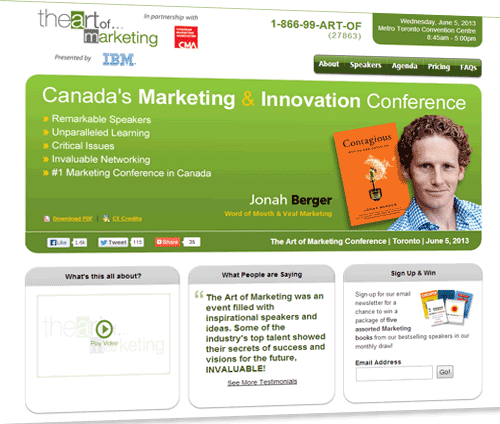This year’s Art of Marketing conference held on June 5th at the Metro Convention Center was nothing short of spectacular. The audience were wide eyed, enthralled and entertained as speaker after industry leading speaker shared their visions, insights and tips on turning marketers into artists and storytellers in order to engage their consumers and win their affection.
 The day started off with a witty opening from advertising guru and comedian Ron Tite. He sets the pace by talking about the need to ‘be greater’ and ‘cut through the clutter”. And then at everyone’s expense, Ron has lumped Ad people into 3 car categories and there was an audience wide applause as well failed to realize we were laughing at ourselves:
The day started off with a witty opening from advertising guru and comedian Ron Tite. He sets the pace by talking about the need to ‘be greater’ and ‘cut through the clutter”. And then at everyone’s expense, Ron has lumped Ad people into 3 car categories and there was an audience wide applause as well failed to realize we were laughing at ourselves:
“When you think of different types of business people, it’s easier to think of all of them as vehicles:
Sales people are like pick up trucks. They have big back ends, don’t mind getting dirty, and when you really need to get stuff done, they can do it.
Finance people are like minivans. they’re kinda geeky, have a ton of gadgets, and they’re in your way whenever you’re trying to get somewhere fast. And like a mini-van, you always think there’s no way in hell you want to be seen with one but then you get one and you think, “..actually these things are pretty handy”.
Marketing people are like PT Cruisers. They look a little different. They think they’re kinda cool. But when you pop the hood, it’s just a friggin’ neon. “
And that got things rolling….
John Gustavson, President and CEO of the CMA’s introduced our line up of some of the industries leaders who were there to speak. So what was the day about? It was about the art and science of marketing and how the blending of both makes it so effective.
However the day was not only about the art, but also about the science of Marketing
We need to find ways to create a system of content that maximizes consumer engagement at every touch point. Its time we change the experience for consumers. No longer are we marketing at them, we’re asking them “let’s make a trade”. That trade is entertainment for attention. This ‘new profession’ follows a set of 3 important imperatives:
- Understand your consumers as an individual
- Create a system of engagement that maximizes value of creation at every touch point
- Design your culture and your brand so they are authentically one
So what’s the takeaway? Marketing isn’t just a message, it’s a behavior and in order to be effective you have to realize we are living in an era of transparency, therefore, we have to behave like the brand because our consumers aren’t just sitting back anymore – they are the new CCO – Chief Customer Officer.
I did NOT see that coming
Core Creativity: How to Bring Creative Change, Innovation & Inspiration to the Work that You Do
Juno Award Winning Musician & Creativity Expert
Now to my favourite part of the day – David Usher. Sure, we like his music and he’s great at combining musical tracks to create a masterpiece but beyond that, I certainly never think of David Usher and marketing in the same thought – until today.
Creativity is 95% work and discipline and 5% inspiration
What drives David Usher crazy? Hearing “I’m just not creative”. Creativity is 95% work and discipline and 5% inspiration. To Usher, creativity is a process and you always have to take ideas, mix them together in order to create something new. He cites his hit “Black, Black Heart’ as an example.
So if you want to truly think and be creative, you have to draw outside of the lines because that is where the magic happens. If you consider a child who doesn’t yet know the rules, they are at their most imaginative and creative. As we get older, we develop roadblocks to creativity and those blocks are resistance and fear.
The best news? It’s okay to fail. In fact, Usher highly recommends it. We have to have both successes and failures in order to see where they will lead. Usher himself has faith in his curiosity. “Ideas stack upon ideas and they take you places you know and have never imagined.” Sounds exciting. What are you waiting for?
I’d end by telling you the incredible cool heartbeat trick Usher did with the audience but I don’t want to ruin his next concert by giving away his surprise!
Yes, it was CONTAGIOUS
Word of Mouth & Viral Marketing
James G. Campbell Assistant Professor of Marketing at Wharton & Author of Contagious: Why Things Catch On
 Jonah Berger speaks highly and repeatedly about ‘word of mouth’ and yes, we’ve all heard it before but somehow Berger manages to again, shed new light on an age-old topic. Just learning that Word of Mouth generates more than twice the sales of paid advertising in categories as diverse as skincare and mobile phones (McKinsey Quarterly) was surprising to the audience, and yet, why?
Jonah Berger speaks highly and repeatedly about ‘word of mouth’ and yes, we’ve all heard it before but somehow Berger manages to again, shed new light on an age-old topic. Just learning that Word of Mouth generates more than twice the sales of paid advertising in categories as diverse as skincare and mobile phones (McKinsey Quarterly) was surprising to the audience, and yet, why?
People have to listen to actual people – not just feeds and forums.
Social media is hot and it’s the tool of the times. However Berger argues that in order to focus on what’s online, we have to also focus on what’s offline. People have to listen to actual people – not just feeds and forums. And regardless of the technology, people will continue to share – good or bad. That’s our nature and we are wise to grasp it.
So in order to understand why people share, we have to understand the psychological drivers:
- Engineer content to be more viral – and there is a formula for this but you’ll have to buy the book.
- Social currency – giving people secrets and VIP status to make them feel special, like insiders who are ‘in the know’
- Triggered – look at Rebecca Black’s hit by hatred song “Fridays” https://www.youtube.com/watch?v=kfVsfOSbJY0. Love it or hate it (and no one actually loves it) people are watching it and when do they watch it the most. Fridays? Go figure. Friday is a trigger. Other triggers come through associations – such as peanut butter and….. ? Now you get it. See how I used one to make you think about the other?
- Emotion – focus on feelings like anger, excitement and humour – because ‘when we care, we share’
- PUBLIC – Monkey see. Monkey Do. It’s true. If we see what someone else is doing, we’re likely to try or follow. We tend to use other people’s choices as a basis for our own so keep that in mind. And if you don’t believe me – do you believe Apple? They put the iconic symbol on their laptop lids so that others would always see what type of laptop you were using. Smart.
- Practical value – this one is simple but often overlooked – be useful or solve a problem for your consumers.
- Stories are the currency of conversation and all good stories have a moral. Like the Trojan horse- your job is create a story with a beginning and a middle to keep your audience engaged so that they don’t mind the moral at the end. So what does this mean? No one wants to share product info but they are happy to share stories. Take the Subway story about Jared for example. We were all curious to see how he progressed on his mission to drop weight. We inadvertently learned that Subway subs had 5% fat but they taught people about the brand by hiding the information inside the story – like the Trojan Horse.
- Inner remarkability – this one was my favourite. You can make any product or service engaging by finding it’s ‘inner remarkability” – something worthy of remark, something surprising, novel or interesting. Without saying more, check out this video to see for yourself: http://willitblend.com. I will just say that Jonah tells us sales went up 700% after this video. Not bad for a $30 budget.
So in short, Jonah reminds us of the ways that behavior contributes to whatever is popular or immediate in our lives.
Wrestling is actually fake – how many of you knew that?
 Innovation & Change with New York Times Bestselling Author, Purple Cow, Tribes & Linchpin, Seth Godin
Innovation & Change with New York Times Bestselling Author, Purple Cow, Tribes & Linchpin, Seth Godin
Seth Godin begins by blowing a certain past time for many in the audience but for most of us – we already knew this. But what about the ones that didn’t? They are now looking at the sport in a different way and seeing the blood pellets and the fake blows. So what did Seth teach us? That different and new information teaches us to learn to see differently.
Seth’s conversation is nothing short of interesting and inspiring and full of valuable nuggets of info. He leads us in by stating that what got us here today, won’t get us there tomorrow. So what does he mean? In today’s consumer environment, all media is optional. No longer are consumers forced to view ads. Not only that, the ‘winning’ is being done on the ‘edges’ – not in the center. The status quo approach isn’t engaging your audience anymore. You have to do something different, weird, do something attention getting. You don’t have a job – you have a platform to do art and what Seth is saying is that we need to fly too close to the sun in order to see what’s out there.
Back in the day, Industrialization made us rich but industrialization is about perfecting – not improving. Not taking risks. That doesn’t work today. Today, humans are connection experts and we do it more than any other species. We are living in the age of the Connection Economy and it is replacing the Industrial economy and how is this happening?
- Coordination – in the Connection Economy – real value is created
- Trust – because when you share a culture, an idea and a goal you can only make it work if you trust
- Permission Marketing and how we can turn strangers into friends and friends into customers.
- Exchange of ideas – All of us are smarter than any of us.
- Generosity – because no one wants to connect or be connected to someone who is just taking and not giving.
Twitter built a system that works better when more people use it. So you have to find a better way to connect for your customers to have the system work better for both of you.
The Connection economy is based on abundance and the Industrial economy was based on scarcity.
Seth is hard to keep up with – the ideas are flying a mile a minute and every one of them is a golden marketing nugget. He goes on to say that the only option is to be ‘the only one’. Be a category ‘of one’ because people want something for them, not for everyone else. And in order to do that we have to create and take risks. The Wright Brothers had the hubris to create to make a difference and now we’re all flying around in airplanes.
So looking back and looking at now – the Connection economy is based on abundance and the Industrial economy was based on scarcity. Today, people are going places because other people are going there too. He cites the Red Hat Ladies. Before the Internet, they would have been a small, local group. Today they are a ‘tribe’. So he encourages us to build a culture, build a tribe and lead it.
Like Usher, Seth enforces the value of failure. As he says ‘the guy who invented the ship also invented the shipwreck.” Touché. Failure is an option and we have to start learning how to use a compass and not a map. You don’t have a ‘job’ – you have art and you make art to lead, to be generous and to make a difference and don’t be afraid to fly too close to the sun.
In this new Connection Economy, we are creating a new world, a new culture and new tribes and they are saying, “Please, we need you to lead us.”
It’s habit forming
Consumer Habits & Predictive Analytics
 Charles Duhigg, New York Times Investigative Reporter & Bestselling Author, The Power of Habit
Charles Duhigg, New York Times Investigative Reporter & Bestselling Author, The Power of Habit
Consumer habits are always being analyzed and utilized in order to find the best way to reach consumers through marketing and advertising. As someone who has never worn a lab coat, I have to admit that the science behind the data is fascinating. For example, if you put a rat in a maze with cheese and hook him up to sensors (see, this is why I won’t wear a lab coat!), his brain activity will register high in finding the cheese. Once he’s been through the maze a few times – the less he thinks about it. This takes XX’s discussion into ‘The Habit Loop” which means we give a cue or trigger (hunger, desire, etc.) and then a routine (eating, exercise) to work towards a reward (a cookie, a satisfied belly). So cues and rewards shape how habits happen and once we know this, we might better be able to understand our own consumers’ consumption habits.
Not only do we know understand the habit forming method, but we can se that starting a habit – like exercise will subconsciously change other habits – such as eating better and procrastinating less.
Now that we understand how habits and “Keystone Habits” work, it’s easy to see through Duhigg’s examples of Target and Starbucks how brands know what shoppers want even before they do and why they buy and what we can learn from it all as marketers. If we can understand why our customers keep coming back from some products again and again then we can change how we position ourselves and get to them before our competitors do.
The audience was rendered Tweetless
 Biz Stone – Things a Little Bird Told Me: Simple Lessons About Business, Life, Service & Creativity
Biz Stone – Things a Little Bird Told Me: Simple Lessons About Business, Life, Service & Creativity
Co-Founder of Twitter, Founder of Obvious & Named one of the Most Influential People in the World by TIME
One woman in the audience was handed the microphone where she declared, “Twitter has totally changed my life.” “Mine too!” responded Biz Stone and he wasn’t kidding. Since it launched in 2006, Twitter has become a top social media tool and brands are using it every which way to reach consumers and build relationships and conversations.
His belief that empathy, partnered with creativity, innovation and an entrepreneurial spirit show us a new way to move forward with a new definition for success.
What Biz share with us is all about new perspectives and new meaning in an ever-changing business environment and culture in general. He attributes success in this fast-paced world to:
- Opportunity
- Creativity
- Technology
- Failure
Failure and the need to embrace it seems to be a common thread today and we’ve heard many inspirational quotes on failing. To add to this, Biz himself says “To succeed spectacularly, you have to be ready to fail spectacularly.” There is a lot of head nodding going on in the audience. Finally- permission to fail!
Biz shared some pretty interesting stories and anecdotes. I thought it was brave to admit that “RT” wasn’t their idea and they didn’t even think it was a particularly good one when they first heard it. However, along with the very witty stories, Biz shared his belief that today, people are attracted to meaning and he has really drawn on this insight to pursue a goal that is focused on the future of marketing through altruism and philanthropy. His belief that empathy, partnered with creativity, innovation and an entrepreneurial spirit show us a new way to move forward with a new definition for success.
Today, Twitter has transformed the way we speak, write, think and communicate not only with brands but also with each other. In this way, Twitter has really helped to transform our industry and revolutionized the role of information. Not bad for an idea Biz didn’t really think was going to go anywhere. What do you expect from GQ’s “Nerd of the Year”?
“At the end of the day” and other over-used marketing speak
When it was all said and done, there was an air of inspiration in the air. You could practically see the thought bubbles as industry attendees were silently stirring up creative chaos in their own minds and conspiring to find exciting new ways to engage consumers using the endless and invaluable info shared in the room that day.
So the next time you hear the words, “The Art Of”, I highly suggest you tune in and sign up. This was a day that will help change the course of marketing for several hundred marketers who were lucky enough to be in the company of some of the biggest names in the business.

